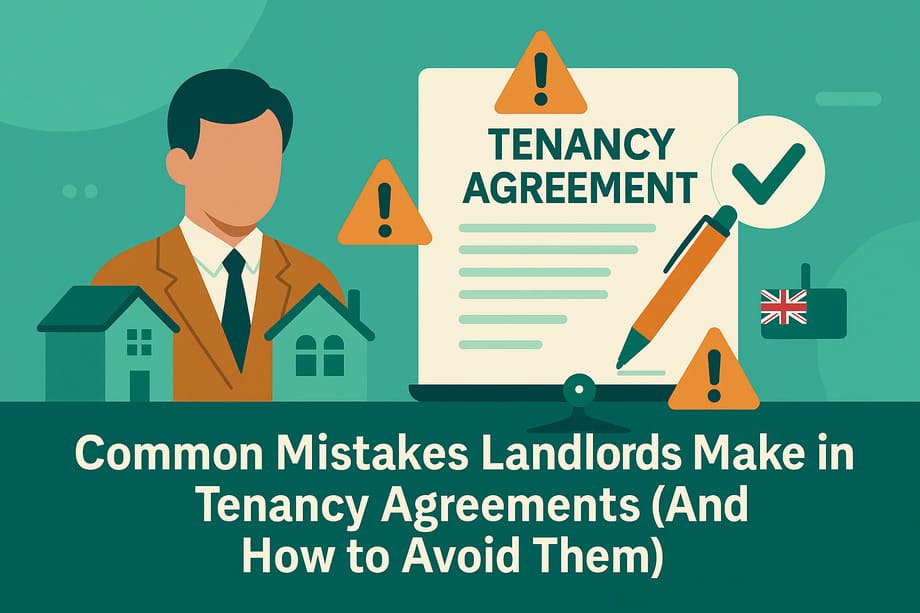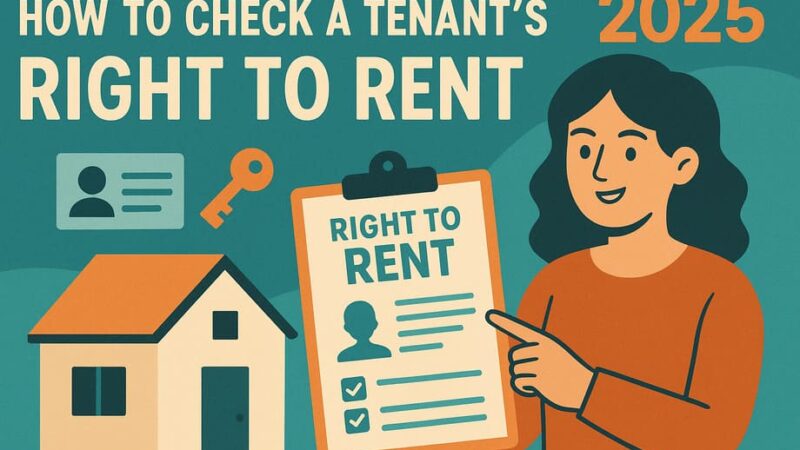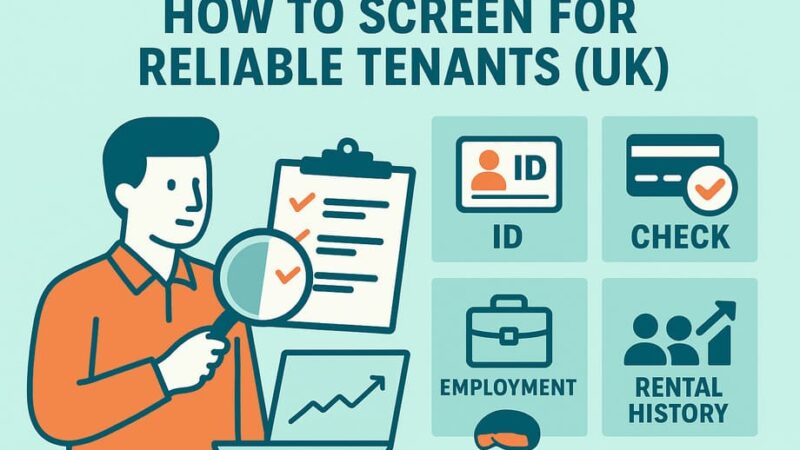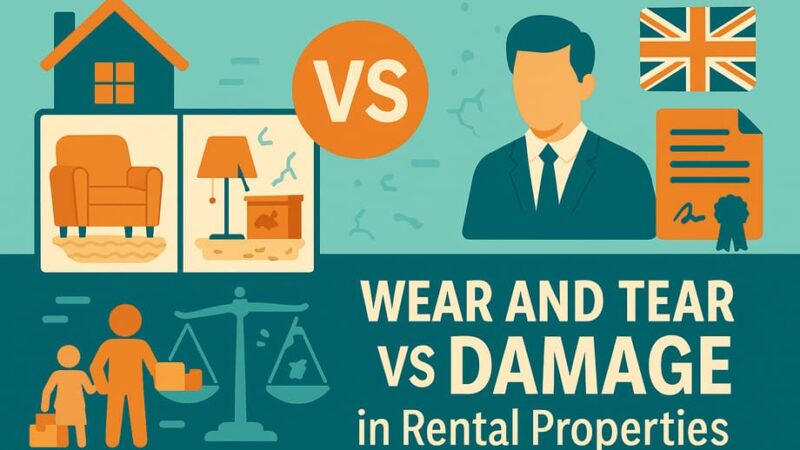Common Mistakes Landlords Make in Tenancy Agreements (And How to Avoid Them)

Your tenancy agreement is the foundation of your landlord-tenant relationship. Get it wrong, and you could face costly legal disputes, unenforceable clauses, or invalid contracts that leave you vulnerable. With UK rental law constantly evolving, even experienced landlords can fall into expensive traps.
Here are the most common tenancy agreement mistakes landlords make – and how to avoid them.
1. Using Outdated or Old Agreements
The Mistake: Many landlords reuse the same tenancy agreement for years, even decades. With rental law changing frequently, your “tried and tested” contract is likely full of outdated or illegal clauses.
Why It’s Dangerous:
- Clauses may no longer be legally enforceable
- Missing recent legal requirements
- Could invalidate your entire agreement
- May prevent you from using possession procedures
The Fix:
- Get a fresh agreement for each new tenancy
- Use up-to-date templates from reputable sources
- Review and update agreements annually
- Never copy and paste from old contracts
Red Flag: If your agreement mentions anything about “fees” or doesn’t reference current deposit protection rules, it’s likely outdated.
2. Not Having a Written Agreement at All
The Mistake: Some landlords, especially when renting to friends or family, skip the paperwork altogether and rely on verbal agreements.
Why It’s Risky:
- No clear record of what was agreed
- Can’t use accelerated possession procedure
- Harder to prove rent amounts or terms
- Disputes become “he said, she said” situations
- Complications when ending the tenancy
The Solution:
- Always have a written agreement, regardless of relationship
- Get it signed before handing over keys
- Even close relationships can break down
- Professional approach protects everyone
Remember: A verbal agreement may be legally binding, but it’s practically useless when problems arise.
3. Including Unenforceable or Illegal Clauses
Common Unenforceable Clauses:
Professional Cleaning Requirements
- The Problem: Requiring tenants to pay for professional cleaning at the end
- Why It Fails: Tenants only need to return property in same condition as start
- The Law: Courts won’t enforce “betterment” clauses
Excessive Property Rules
- Examples: Must hoover twice weekly, shoes off indoors, specific cleaning schedules
- Reality: Impossible to monitor or enforce
- Issue: Interferes with tenant’s “quiet enjoyment”
Shifting Landlord Responsibilities
- Illegal Terms: Making tenants pay for gas safety certificates, structural repairs, or landlord’s legal obligations
- Result: Completely unenforceable and makes you look unprofessional
The Fix: Stick to reasonable, enforceable terms that don’t override statutory rights.
4. Inadequate Property Description
The Mistake: Providing vague or incomplete property details in the agreement.
What Should Be Included:
- Full property address including postcode
- Whether furnished, part-furnished, or unfurnished
- Which utilities are included in rent
- Available amenities (parking, garden, etc.)
- Any restrictions or property-specific rules
- Inventory reference details
Why It Matters:
- Sets clear expectations for both parties
- Helps avoid disputes about what’s included
- Essential for deposit deductions at end of tenancy
- May be required for insurance purposes
5. Unclear Rent and Payment Terms
Common Problems:
- Not specifying rent is payable in advance
- Missing payment due dates
- Unclear about what rent includes
- No late payment procedures outlined
- Vague about payment methods
Essential Rent Clauses:
- Exact monthly rent amount
- Payment due date (e.g., 1st of each month)
- Payment method (bank transfer, standing order)
- Whether rent includes utilities, council tax
- Late payment charges (if applicable)
- Rent review procedures
Pro Tip: Be specific. “Rent payable monthly” isn’t enough – state “£1,200 per month, payable in advance on the 1st of each month.”
6. Missing Key Legal Requirements
Deposit Protection Information:
- Must protect deposits within 30 days
- Must provide prescribed information to tenants
- Failure prevents serving Section 21 notices
- Can face court action for non-compliance
Essential Documents to Provide:
- How to Rent guide (current version)
- Energy Performance Certificate
- Gas Safety Certificate
- Electrical Installation Condition Report (if required)
- Deposit protection scheme details
Right to Rent Checks:
- Must check and record tenant’s right to rent
- Take copies of acceptable documents
- Re-check if limited right to rent expires
7. Incorrect Tenancy Type
The Mistake: Using the wrong type of tenancy agreement for your situation.
When AST May Not Apply:
- Rent exceeds £100,000 per year
- Landlord lives in same building (sometimes)
- Business or company tenancy
- Holiday lets or temporary accommodation
Why It Matters:
- Wrong agreement type affects your rights
- May impact eviction procedures
- Could affect tax treatment
- Insurance may not be valid
The Solution: Get professional advice if unsure about tenancy type.
8. Missing or Incorrect Tenant Details
Essential Tenant Information:
- Full legal names of all adult occupiers
- Current addresses before tenancy starts
- Contact details (phone, email)
- Emergency contact information
- Number of people allowed to live in property
Common Mistakes:
- Not naming all adults on agreement
- Allowing occupiers not on the agreement
- Missing emergency contacts
- Unclear about visitors and guests
Why It Matters: Anyone not named may have rights to stay even after named tenants leave.
9. Vague Maintenance and Repair Clauses
What to Specify Clearly:
- Landlord’s repair responsibilities (structure, heating, plumbing)
- Tenant’s maintenance duties (garden, minor repairs)
- Reporting procedures for repairs
- Emergency contact arrangements
- Response times for different types of repairs
Avoid These Mistakes:
- Making tenants responsible for landlord’s legal obligations
- Unclear about who pays for what
- No procedure for reporting problems
- Unrealistic response times
10. Insufficient Termination and Notice Clauses
What Must Be Included:
- How either party can end the tenancy
- Required notice periods for different scenarios
- Proper notice serving procedures
- What happens at end of fixed term
- Break clause details (if applicable)
Common Problems:
- Contradictory notice requirements
- Missing break clause procedures
- Unclear about periodic tenancy rules
- No mention of Section 21/Section 8 processes
11. Overlooking Joint Tenancy Issues
For Multiple Tenants:
- Make all adults joint and severally liable
- Clear rules about tenant changes
- What happens if one tenant wants to leave
- Shared responsibility for all rent and damages
- Rules about subletting or additional occupiers
Common Mistakes:
- Individual liability instead of joint
- No procedures for tenant replacement
- Unclear about shared areas in HMOs
- Missing rules about additional occupiers
12. Ignoring Modern Requirements
Digital Age Considerations:
- Email contact preferences
- Electronic document delivery
- Online rent payment systems
- Digital inspection procedures
- Data protection compliance
Health and Safety Updates:
- Smoke alarm requirements
- Carbon monoxide detector rules
- Electrical safety standards
- Energy efficiency requirements
- Selective licensing compliance
How to Create a Bulletproof Tenancy Agreement
Professional Templates
Avoid these mistakes by using our free tenancy agreement template, which includes:
- Current legal requirements
- Enforceable clauses only
- Clear, plain English
- Comprehensive coverage of key issues
- Regular updates for law changes
Essential Steps:
- Start Fresh: Don’t copy old agreements
- Use Professional Templates: From reputable sources or legal professionals
- Keep It Clear: Use plain English, avoid legal jargon
- Include Everything: Don’t leave important terms to chance
- Get Legal Review: For complex situations or bespoke clauses
- Regular Updates: Review and refresh regularly
Before You Sign:
- Double-check all names and addresses
- Verify rent amounts and payment terms
- Ensure all required documents are referenced
- Confirm deposit protection details
- Review with tenant to avoid misunderstandings
Warning Signs Your Agreement Needs Updating
Immediate Red Flags:
- Agreement is more than 2 years old
- Contains tenant fee clauses
- Missing deposit protection information
- Unclear about Right to Rent requirements
- No reference to current safety requirements
Time for a Review:
- After any major law changes
- When regulations update
- Before each new tenancy
- If you’ve had disputes about unclear terms
- When insurance or licensing requirements change
Professional Help vs DIY
When to Get Professional Help:
- Complex property situations (HMOs, commercial)
- Bespoke clauses needed
- Previous agreement disputes
- Unusual tenant arrangements
- High-value properties
Quality Template Sources:
- Landlord associations (NRLA, RLA)
- Professional property management companies
- Legal document providers
- Specialist letting software
The Cost of Getting It Wrong
Potential Consequences:
- Unenforceable agreements
- Failed possession proceedings
- Deposit protection penalties (up to 3x deposit)
- Court costs and legal fees
- Lost rental income during disputes
- Damage to professional reputation
Prevention is Cheaper: Investing in a proper agreement upfront costs far less than fixing problems later.
Key Takeaways
Essential Reminders:
- Your tenancy agreement is a legal contract – treat it seriously
- The law changes frequently – keep agreements current
- Clear, enforceable terms prevent disputes
- Professional templates save time and money
- When in doubt, get legal advice
Golden Rules:
- Never hand over keys without a signed agreement
- Don’t include unenforceable clauses
- Keep language clear and specific
- Include all legal requirements
- Update regularly as laws change
Bottom Line: A well-drafted tenancy agreement protects your investment, prevents disputes, and demonstrates professionalism. Don’t cut corners on this crucial document.
Getting your tenancy agreement right from the start saves time, money, and stress later. Take the time to create a comprehensive, legally compliant agreement – your future self will thank you when everything runs smoothly.
Remember: Prevention is always better than cure, and a solid tenancy agreement is your first line of defense against rental property problems.
Last Updated on October 23, 2025 by James Cartwright







